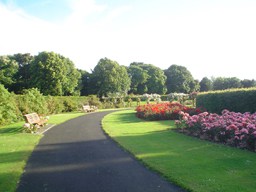St. Anne’s Rose Garden
The Genesis of St. Anne’s Rose Garden began in 1970 when the efforts of Clontarf Horticultural Society (founded 1954) and the Parks Department of Dublin Corporation combined to create what is today an International Rose Garden.
The variety of roses in this jewel are to numerous to mention. Even a lack of understanding of rose cultivation does not prevent an individual’s sense of appreciation of colour and fragrance. St. Anne’s Rose Garden is a fitting tribute to men and women whose creative talent and hard work are boundless. Future generations will look, ponder and admire this awesome creation.
Great Cities need Art Galleries, Museums, Theatres, Cathedrals and Public Gardens to give expression and direction to man’s search for identity. It is the force of spirit which rises in one form or another in all human association which motivated The Royal Horticultural Society of Ireland in their representations to Dublin Corporation’s Parks Department in 1963, requesting that a Public Rose Garden be designed in the City of Dublin.
The seed, so carefully sown at this time, failed to germinate until The Clontarf Horticultural Society acting under the same force raised the question again during 1970. On this occasion the enthusiasm generated by the meeting of minds set off a train of events which led to the planting of a Rose Garden at St. Anne’s Park, Clontarf during 1974.
St. Anne’s Park, which provides a setting for the young Rose Garden covers 266 acres of landscaped grounds at Clontarf was the former home of the Guinness family of Brewery fame. These grounds were planted about 1880 along Reptonian lines using Holm Oak and Pine to provide shelter from the sea winds and a background against which to view the lighter colours of Ash, Beech, Oak, Elm, Chestnut and Lime.
The site selected for the Rose Garden was a field in area of about 10 acres, which has provided space for four football pitches since 1950. Its design advantages were, easy accessibility from the public road at Mount Prospect Avenue, a perfect visual setting by way of mature background trees consisting of Quercus ilex (Holm Oak), Pinus nigra Austriaca (Austrian Pine), some Elm and dramatic groups of Tilia platyphyllos (Broad leafed Lime). It’s disadvantages were, exposure to the south west prevailing winds, a rather thin poor top soil and a flatness of character which was ideal for football but suggested monotony for land use requiring greater subtle and variation.
Based on the principle that a Public Rose Garden has much in common with an Art Gallery in that each must have space division and background colour, they must cater for public movement and circulation and will be rendered more interesting by a variation in levels, a design was conceived.
Successful Irish artists Delorentos perform live in St. Anne’s Rose Garden
– courtesy of aertv’s back to basics series.
To create the necessary intricacy, variety, space division and unity and to overcome the overall flatness of the site, a number of techniques were used in the design:-
1. About 10,000 cubic yards of soil were excavated from a central area and placed around the perimeter of the site, to form a sunken garden in the centre and sloping banks four feet in height on the perimeter.
2. 2,000 plants of young beech were planted on top of these banks and around the sunken area to form hedges which will emphasise the division of space, provide background against which to view Roses and to create shelter which will render the garden more agreeable for Rose culture and more pleasant for visitors.
3. This space division was further defined by the construction of Pergolas and Pillars used for the display of Climbing and Rambling Roses.
The predominant background colour on the site is the dark green of Quercus ilex (Holm Oak) and Pinus nigra Austriaca (Austrian Pine), this has been reinforced by additional planting and the colour of this material is relieved by existing groups of Tilia platyphyllos (Broad leafed Lime) which have been extended to punctuate the skyline and mark the entrance points to the Rose Garden. About 150 Lime trees have been planted with this purpose in mind.
To cater for the public movement and circulation, some 4,500 square yards of paths have been laid, apart from providing a dry hard wearing surface, the paths have a colour and texture which give contrast to the design.

The Rose beds are set in a surface of lawn grass and every type of Rose represented here. Old Shrub Roses, Climbing and Rambling Roses, together with a selection of modern Hybrid Tea and Floribunda Rose, 6,000 of these were planted since that time. This development is the latest in a long tradition of good gardening at St. Anne’s Park.
Follow the St. Anne’s Trail
Article courtesy of St. Anne’s Park
